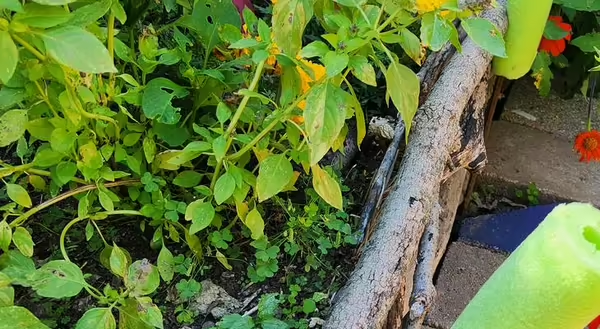
By May Bach, Extension Master Gardener and Master Naturalist serving Fulton, Mason, Peoria and Tazewell counties
In the spring of 2024, three local Extension Master Gardeners created a hügelkultur bed inside the Wildlife Prairie Park 4-H Learning Garden that has become an excellent rain runoff control agent, productive garden bed, and another fun attraction for visitors.
Hügelkultur means hill garden. The most remarkable thing about a hügelkultur is you create this “hill” from simple left-over organic elements you might find in your trash pile or in the things other gardeners might haul to the landfill. Large logs, the more rotten, the better, and branches, leaves, straw, and even brown uncoated cardboard are the materials used to create the hill used then as an organic raised bed. Think of it as a compost pile used to seed or grow transplants on top, just as you use any other type of raised bed or garden site.
Steps of hügelkultur construction
Location and size
Begin by digging a trench or shallow pit of the length and width you determine ideal for your selected location. Your location determines the plants you can later grow in your hügelkultur based on the amount of sun received or the other elements present. Once you create a hügelkultur, you won’t move it anytime soon, so location is an essential first step. The pit depth can be several inches to a few feet deep. The size of your largest logs often determines the depth. Make the pit deep enough to have the largest logs below ground level.
Logs and layers
Place the largest logs you have inside to fill the pit. Keep them close together, as this is the base level of your construction. The old/rotten logs act as a water battery by retaining moisture, and this base level also controls rain runoff. Controlling runoff has benefited our WPP 4-H Learning Garden hügelkultur construction. On top of these logs, you place large and small branches, perhaps leaves, straw, or some brown uncoated cardboard torn into smaller pieces. Whatever organic materials you choose, you put carbon or brown compost material into your construction. Once you add back some of the soil you removed while creating the pit, you have completed the base level of your hügelkultur. Add additional layers until you have the height you desire. Remember that you want to end your final level of construction with at least 10-15 inches of soil on the top to allow most plants to grow a healthy root system. As the materials inside the pile decompose, you’ll have a deeper growth ability.
You decide how high you want your hügelkultur to be. The width is also your decision, again based on the size of the pit you dig. If you look online for examples of this method, you’ll find some references to this process that requires heavy digging equipment, creating hügelkulturs the size of natural hills. However, that size and complicated construction are not necessary for you to try this old gardening method and enjoy success with the result. Plan your finished hügelkultur to be no larger than the Extension recommended average raised bed. A width of 3 feet or less allows reach-in access, wider if you have access to both sides, and a completed height of 1-3 feet or slightly more, making working in the bed a more comfortable experience for most adults. You may need to add several layers of brown materials topped with soil to achieve your desired height. Remember that your hügelkultur will settle and become shorter as the season progresses.
Waddle fence
After we finished attaining the desired height of our hügelkultur inside the Wildlife Prairie Park 4-H Learning Garden, we used long branches combined with some upright-placed stakes and rebar to hold in the sides. Using those long branches and upright supports, we created a wall structure similar to a waddle fence, another old gardening method that usually takes unused materials to weave a holding wall. Again, with our waddle fence wall and hügelkultur, we built gardening items using materials typically cast aside but became useful and attractive.
Our hügelkultur is an excellent rain runoff control agent and a very productive garden bed. It also gains much interest from park visitors and is yet another gardening method and learning feature fully displayed inside our happy little garden. Please visit our garden; all are welcome!